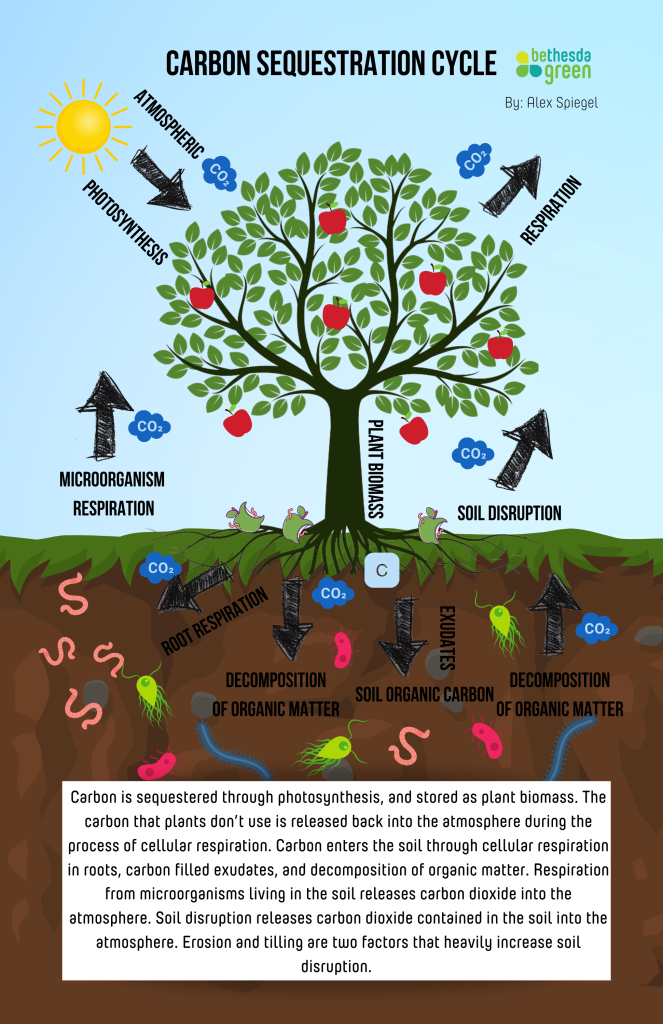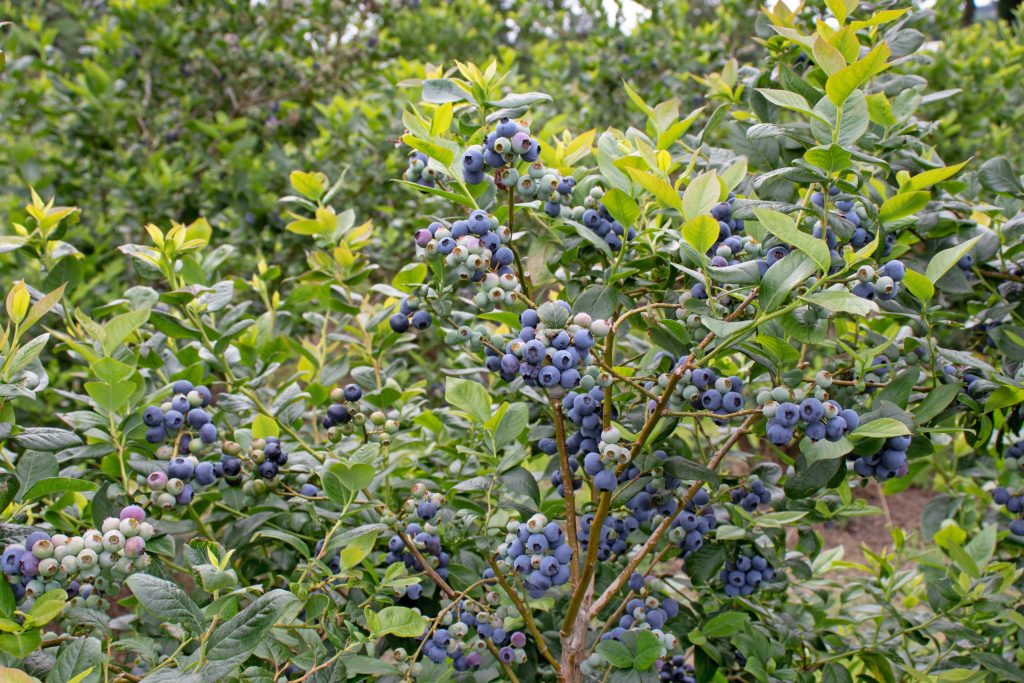Tips to Gardening More Carbon Consciously
By Alex Spiegel, 2021-2022 Environmental Leader
Introduction to Carbon Sequestration:
By trapping heat from the sun, greenhouse gasses have kept Earth’s climate habitable for humans and millions of other species. But now, gasses such as carbon dioxide are out of balance and threaten to drastically change the way of life for many living things. Carbon dioxide is the most prevalent greenhouse gas, and it has reached its highest levels recorded in the atmosphere. Greenhouse gasses cause climate change when out of balance, which creates a wide range of negative environmental and health effects (NatGeo). Biological carbon sequestration refers to the storage of carbon dioxide in plants, soil, and even aquatic environments (UC Davis). Biological carbon sequestration is an effective way to reduce the amount of carbon dioxide that is stored in the atmosphere, and, in turn, slow down climate change. Traditional gardening and farming methods can oftentimes limit carbon sequestration (CS Report). Interestingly though, more carbon is stored in the planet’s soil than in living things and the atmosphere combined. Over the past century, however, soil carbon has been widely depleted, highly due to unsustainable land management practices that prevent natural processes that create carbon-rich organic matter (Audubon).

Carbon sequestration cycle. Source: Alex Spiegel
1. Leave the Dirt Alone:
Soil disruption is any plowing, tilling, soil movement that releases carbon back into the atmosphere. Plowing, rototilling, or even digging with a spade or garden fork exposes soil microorganisms to excess oxygen and sunlight, accelerating the loss of stored carbon to the atmosphere (Audubon). Some of the most important microorganisms in the soil are mycorrhizal fungi. Plants genetically know that mycorrhizal fungi are going to extend the gathering capacity of roots, and gather all kinds of resources for the plant that the plant is not able to get by itself, so the mycorrhizal insert themselves into the plant’s roots. This includes water, and probably at the top of the list, phosphorus; phosphorus is generally tightly bound up chemically with other minerals in the soil like calcium. These fungal mycelia may extend out for a foot or two feet year after year. The nutrient gathering capability of a plant can increase by a hundredfold. Mycorrhizal fungi, in particular, are known to be integrally involved with carbon sequestration.
One of the ways they are involved in carbon sequestration is through producing a substance called Glomalin. Glomalin converts to humic material that ends up being stable in the soil. These complex humic molecules are relatively unreactive, so, in other words, it’s difficult for bacteria to eat them. As long as they’re in the soil, and there is no plowing done to them, there won’t be a lot of oxidation.
The reverse process explains the destruction of humic materials. For millennia, humans have been plowing the soil; it has been extremely disruptive to the carbon sequestration process. Plowing physically disrupts the fungal mycelia. When soil is plowed, it literally
rips up and macerates all of the fungal mycelia. Not only does it harm the nutrient gathering capability of plants, but it also has implications for carbon sequestration. These implications are because of all the glomalin, and the organic matter of the mycelia themselves; every time the soil is plowed – the mycorrhiza, or the population- the synergy between plants and carbohydrates that are being produced by plants that are feeding these fungal mycelia is reduced. By destroying these mycorrhizal networks the amount of carbon stored in the soil diminishes because the glomalin is disrupted and cannot stably hold carbon (Ed Huling).
2. Reduce Synthetic Fertilizer Use:
Inorganic fertilizers also known as commercial or synthetic fertilizers go through a manufacturing process and contain only a few nutrients – generally nitrogen, phosphorus, potassium, sulfur and sometimes micronutrients. These nutrients are in a form readily available to plants (OSU Extension).
Bacteria are roughly 20% protein, and the largest component of nitrogen is protein. Bacterial populations will spike when a concentrated source of nitrogen is provided to the soil; the population growth will force the bacteria to look to the humus as a source of carbon in order to complete their physical growth (Ed Huling). Essentially, once the
bacteria intake all of the nitrogen, they will move on to the organic matter in the soil. Over time, this results in a dramatic reduction of the amount of carbon in the soil (Audubon).
Application of manure, biosolids, or compost boosts soil health by adding organic material and nitrogen and reducing the need for synthetic nitrogen fertilizer. In addition, nitrogen is released more slowly from these organic amendments than from synthetic fertilizer, making it less likely to be lost through conversion to nitrous oxide or nitrate before it can be taken up by the crop. Organic amendments also benefit soil health and increase crop growth in other ways. Extra organic matter helps hold water in the soil, while nutrients other than nitrogen that are released by decomposition also increase plant growth. The larger plants that result sequester more carbon because the greater root biomass and healthier plants produce more root exudates. Larger plants may also leave more residue both above and below ground, increasing the organic matter added to the soil. Manure and composted food or yard waste are some of the best organic amendments (CS Report).

Organic compost. Source: Shutterstock.
3. Grow Perennial Plants:
Annual plants are plants that only live for one season. An annual will sprout, flower, seed and then die — all in one year. Perennials live for three or more growing seasons. They require less maintenance than annuals because they grow back each year from the roots that go dormant in the winter. They put their energy into growing strong roots rather than growing lots of flowers like annuals do; perennials can still grow attractive flowers and be visually appealing (HGTV).

Perennial blueberry bush. Source: Shutterstock.
Perennials have longer roots which allow them to hold onto moisture and carbon, making soil healthier, even during extreme weather (Medhill). All plants can sequester carbon to some degree, but those with deep roots will store that carbon more effectively. Perennial plants are also effective in land management for carbon sequestration. The deep, woody roots will remain in place for quite some time, so perennials should help keep that carbon locked in the soil for years (PFAF).
In comparison to annual plants, perennials do not leave soil barren and susceptible to erosion. Which, as stated, harms the mycorrhiza, and decreases the net primary production of the overall area. Along with maintaining healthy soil, there is also constant photosynthesizing year round; carbon will continue to be stored in plant biomass and the soil during all of the seasons (Ed Huling).
It is our job to protect the environment, and it is crucial that everyone does their part in dealing with climate change. Luckily, every action, large or small, will be a step taken towards keeping earth healthy. Taking steps to fight climate change can also be extremely fun, and bring people together. There are plenty of ways to reduce your carbon footprint, but gardening with these tips in mind is just one exciting, and easy way to do so. Now, I call on the gardeners to help construct a brighter future through practicing these tips!
References:
Davis, U. C. (2021, November 5). Biological Carbon Sequestration. UC Davis. Retrieved March 7, 2022, from
https://www.ucdavis.edu/climate/definitions/carbon-sequestration/biological#:~ :text=Biological%20carbon%20sequestration%20is%20the,as%20in%20soils%20a nd%20oceans.
Extension, O. S. (2022, February 23). Here’s the scoop on chemical and organic fertilizers. OSU Extension Service. Retrieved March 7, 2022, from https://extension.oregonstate.edu/news/heres-scoop-chemical-organic-fertilizers
Francis, M., & Potts, L. (n.d.). What’s the difference between an annual and a perennial? HGTV. Retrieved March 7, 2022, from
https://www.hgtv.com/outdoors/flowers-and-plants/flowers/flower-power-annua ls-vs-perennials
Google. (2022, March 7). Interview with Ed Huling.docx. Google. Retrieved March 7, 2022, from
https://docs.google.com/document/d/e/2PACX-1vTWuly19Ihi_LI-J2RV-NUoa8d 8g4yEDUJJNWP7J3mkaagb9SD35UW2LBlH70q25Q/pub
Marinelli, J. (2019, April 19). The Hidden Carbon Trap in your garden? it’s all about the soil. Audubon. Retrieved March 7, 2022, from
https://www.audubon.org/news/the-hidden-carbon-trap-your-garden-its-all-abou t-soil
Nunez, C. (2021, May 3). Carbon dioxide in the atmosphere is at a record high. here’s what you need to know. Environment. Retrieved March 7, 2022, from https://www.nationalgeographic.com/environment/article/greenhouse-gases#:~:t ext=They%20cause%20climate%20change%20by,change%20caused%20by%20gr eenhouse%20gases.
Plants for a Future. (n.d.). Carbon Sequestration. Pfaf. Retrieved March 7, 2022, from
https://pfaf.org/user/cmspage.aspx?pageid=324#:~:text=Deep%20Rooted%20Pe rennial%20Plants,land%20management%20for%20carbon%20sequestration.
Prieur, D. (2016, August 25). Perennial plants can fight climate change, says dr. Jerry Glover… Medill News Service. Retrieved March 7, 2022, from https://dc.medill.northwestern.edu/blog/2016/08/04/perennials-fighting-climate -change/
Via, Sara. (2021). Increasing Soil Health and Sequestering Carbon in Agricultural Soil: A Natural Climate Solution. Izaak Walton League of America and National Wildlife Federation. retrieved March 7, 2022, from
https://www.iwla.org/docs/default-source/conservation-docs/agriculture-docume nts/via-2021-carbon-sequestration-report-final_lowres.pdf?sfvrsn=2bb28e0d_12
About the Author:
 Alex Spiegel, 2021-2022 Environmental Leader
Alex Spiegel, 2021-2022 Environmental Leader
Alex is a Senior at Bethesda-Chevy Chase High School. He has always been passionate about the environment, which is why he joined the Environmental Leaders Program at Bethesda Green! He’s extremely excited to be able to help create a better future for the environment as part of the Bethesda Green Environmental Leaders program. His passions other than the environment include soccer, music, and cooking.





